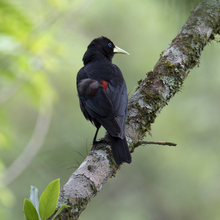Red-rumped cacique
The red-rumped cacique (Cacicus haemorrhous) is a species of bird in the family Icteridae. It is a species of the Amazon Basin and the Guyanas in northern South America, and is only coastal there in the Guyanas and the Amazon River outlet to the Atlantic; a separate large disjunct range exists in all of south-eastern and coastal Brazil, including Paraguay, and parts of north-eastern Argentina. It is also found in Bolivia, Brazil, Colombia, Ecuador, French Guiana, Guyana, Peru, Suriname, and Venezuela.
| Red-rumped cacique | |
|---|---|
 | |
| Scientific classification | |
| Kingdom: | Animalia |
| Phylum: | Chordata |
| Class: | Aves |
| Order: | Passeriformes |
| Family: | Icteridae |
| Genus: | Cacicus |
| Species: | C. haemorrhous |
| Binomial name | |
| Cacicus haemorrhous (Linnaeus, 1766) | |
| Synonyms | |
|
Oriolus haemorrhous Linnaeus, 1766 | |
The red-rumped cacique's natural habitats are subtropical or tropical moist lowland forests, subtropical or tropical swamps, and heavily degraded former forest.
In 1760 the French zoologist Mathurin Jacques Brisson included a description of the red-rumped cacique in his Ornithologie based on a specimen collected in Cayenne in French Guiana. He used the French name Le cassique rouge and the Latin name Cassicus ruber.[2] Although Brisson coined Latin names, these do not conform to the binomial system and are not recognised by the International Commission on Zoological Nomenclature.[3] When in 1766 the Swedish naturalist Carl Linnaeus updated his Systema Naturae for the twelfth edition, he added 240 species that had been previously described by Brisson.[3] One of these was the red-rumped cacique. Linnaeus included a brief description, coined the binomial name Oriolus haemorrhous and cited Brisson's work.[4] The specific name haemorrhous combines the Ancient Greek words haima "blood" and orrhos "rump".[5] The red-rumped cacique is now the type species in the genus Cacicus that introduced by the French naturalist Bernard Germain de Lacépède in 1799.[6][7]
References
- BirdLife International (2012). "Cacicus haemorrhous". IUCN Red List of Threatened Species. 2012. Retrieved 26 November 2013.CS1 maint: ref=harv (link)
- Brisson, Mathurin Jacques (1760). Ornithologie, ou, Méthode contenant la division des oiseaux en ordres, sections, genres, especes & leurs variétés (in French and Latin). Volume 2. Paris: Jean-Baptiste Bauche. pp. 98–100, Plate 8 fig 2. The two stars (**) at the start of the section indicates that Brisson based his description on the examination of a specimen.
- Allen, J.A. (1910). "Collation of Brisson's genera of birds with those of Linnaeus". Bulletin of the American Museum of Natural History. 28: 317–335. hdl:2246/678.
- Linnaeus, Carl (1766). Systema naturae : per regna tria natura, secundum classes, ordines, genera, species, cum characteribus, differentiis, synonymis, locis (in Latin). Volume 1, Part 1 (12th ed.). Holmiae (Stockholm): Laurentii Salvii. p. 161.
- Jobling, J.A. (2018). del Hoyo, J.; Elliott, A.; Sargatal, J.; Christie, D.A.; de Juana, E. (eds.). "Key to Scientific Names in Ornithology". Handbook of the Birds of the World Alive. Lynx Edicions. Retrieved 1 May 2018.
- Lacépède, Bernard Germain de (1799). "Tableau des sous-classes, divisions, sous-division, ordres et genres des oiseux". Discours d'ouverture et de clôture du cours d'histoire naturelle (in French). Paris: Plassan. p. 6. Page numbering starts at one for each of the three sections.
- Paynter, Raymond A. Jr, ed. (1968). Check-list of birds of the world. Volume 14. Cambridge, Massachusetts: Museum of Comparative Zoology. p. 144.
External links
| Wikimedia Commons has media related to Cacicus haemorrhous. |
- Red-rumped cacique videos - Internet Bird Collection
- Stamps (for Suriname) with range map – (shows disjunct range on south-east coastal Brazil)
- Red-rumped cacique photo gallery - VIREO Photo-High Res
- Photo; Article-(High Res: photo gallery: Nest, preening, Surinam map, etc.) - https://www.nhlstenden.com/

